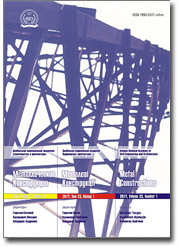The valid load-carrying capacity of one-bolted joints taking into account technological features of formation of an aperture
Abstract: Power Transmission Lines (PTL) represent a spatially-rod design which consist of rolling L-steels connected in knots bolts working on bearing and cut. In supports PTL elements with insignificant thickness – from 4 to 12 mm are mainly used. In such designs theoretically bolted joint refusal occurs in a consequence bearing connected elements. On practice refusal of one-bolted joints occurs because of a cut of a bolt or element destruction on the weakened sectional view. The analysis of calculation of bolted joints under the standard documents operating in Ukraine and abroad that they different from each other. In all considered size standards the technique of formation of apertures accurately does not make a reservation. The spent experimental researches have shown that the bolted joints formed by a method of a punching, perceive loadings exceeding settlement. Such misfitting of work of a bolted joint is caused by two factors – in definition of efforts смятия, there is a stock on durability; the punching of apertures leads to increase in a mechanical material properties.
Keywords: settlement resistance, supports of Power Transmission Lines, stability, a bearing stress, an experimental model, a bolted joint, refusal of work of a bolted joint.
Pages: 237-244.
For citation: Vasylev, V. N.; Shevchenko, Ye. V.; Karabanov, A. S. [et al.]. The valid load-carrying capacity of one-bolted joints taking into account technological features of formation of an aperture. – Text : electronic. – In: Metal Constructions. – 2012. – Vol. 18, N 4. – Р. 237-244. – URL: https://donnasa.ru/publish_house/journals/mk/2012-4/03_vasylev_schevchenko_karabanov_tanasoglo.pdf (date of access: 22.11.2024). – ISSN 1993-3517.

Vol. 18, N 4 (2012)
Journal: Metal Constructions
Publish house: Donbas National Academy of Civil Engineering and Architecture
Journal: Metal Constructions
Publish house: Donbas National Academy of Civil Engineering and Architecture
